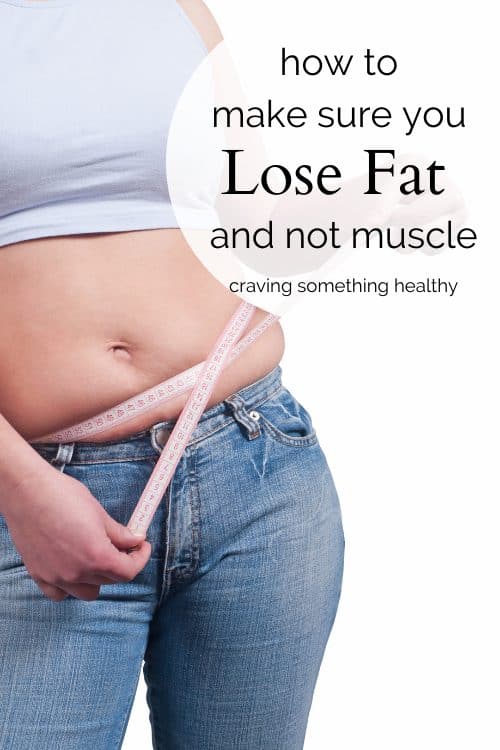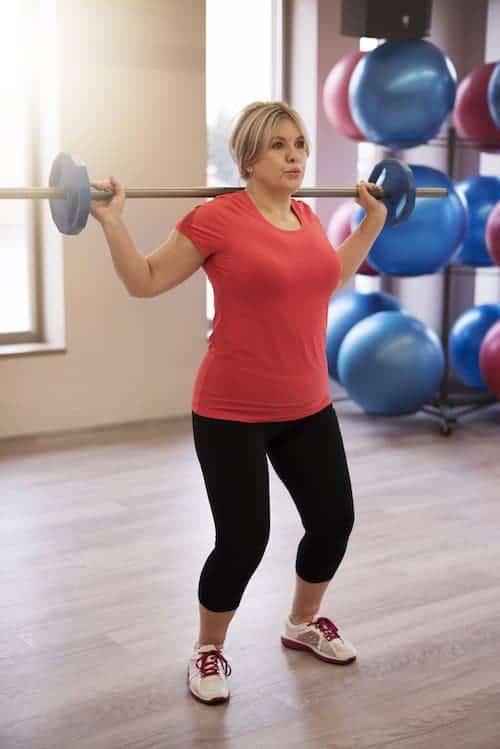Tips for Fat Loss vs. Weight Loss After Menopause
Have you decided it’s time to drop a few pounds? You should know there’s a difference between fat loss vs weight loss. While it’s fairly easy to lose weight, losing fat takes more work and a different approach. But the payoff is much greater.
Here’s why fat loss is more important than weight loss, and some tips for saying goodbye to that excess belly fat.
Is there anyone out there who doesn’t get just a little bit depressed when your scale tells you you’re a few pounds heavier than last month, or last year? It happens to all of us, especially if you’re approaching menopause. It’s not unusual to gain a few pounds as you age, but it’s important to remember not all weight is created equal.
Where Do You Store Your Fat?
Your body shape, and where you store fat that tells a bigger story than that number on the scale. Fat in the lower part of your body (hips and thighs) might not make you happy, but it probably won’t have a significant impact on your health. However, if most of your weight gain is from fat around your waistline, you’re at a much higher risk of things like:
- High blood pressure
- Heart attack
- Stroke
- Diabetes
- Some types of cancer
- Non-alcoholic fatty liver disease
- A much more serious case of Covid-19, according to this study
The loss of estrogen that happens with menopause makes it easier for women to store fat in the abdominal or belly region. Note - this is not the "pinch an inch" type of fat that sits near your skin, the kind of fat I'm talking about here is deep inside your abdomen and around your liver. It gives you that apple shape vs a pear-shaped body.

To determine if you have too much abdominal (also known as visceral) fat, use a tape measure to measure your waist. Wrap the tape measure around your waist, just above your hipbones, and across your belly button (here are instructions from the CDC).
A waist circumference over 35 inches for women (or over 40 inches for men), means you’re at increased risk for the metabolic diseases listed above.
The reason belly fat is so bad for you, is because it doesn’t just sit there. Abdominal fat is metabolically active.
It releases hormones, inflammation-promoting compounds, and fatty acids that raise your blood pressure, triglycerides, and blood sugar, and makes LDL (bad) cholesterol more likely to form plaques in your blood vessels. Abdominal fat also causes insulin resistance, which is linked to diabetes and breast cancer in postmenopausal women.
Why Fat Loss is More Important Than Weight Loss
If you cut your calories way back for a few weeks or months, you will lose weight – and that number on the scale might make you happier. However, when you lose weight by dieting alone, you’ll lose mostly muscle, not fat. Abdominal fat is very stubborn and wants to stay right where it is. On the other hand, muscle (and water) come off very quickly
That kind of weight loss makes you “skinny-fat” – normal weight but still with too much belly fat and thus, the health risks.
And, when weight loss due to muscle loss instead of fat loss, your metabolism slows down. That, in turn, eventually leads to more weight gain. And if you’re prone to gaining weight in your abdomen…, you guessed it, that’s where more fat will end up.
Weight loss without fat loss is a vicious cycle. But there are ways to break that cycle so the weight you lose is mostly fat.
How to Lose Fat Instead of Just Weight
Fat loss vs weight loss takes more work than just restricting calories. Getting (and keeping) the fat off requires a holistic approach. That’s because abdominal fat is more likely to happen because of a combination of:
- The type of foods you’re eating (sugar, refined carbs, and processed foods)
- Hormonal changes
- Stress
- Poor sleep
- Inadequate or the wrong type of exercise
The best way to ensure that you’re losing fat and not just weight (muscle and water) is to attack all five of those areas. Here’s how:
Eat a lower carb, low glycemic diet
There’s no need to go keto-low, just try to steer clear of sugar and refined carbs (at least 90% of the time). These include:
- all sweets and sweetened beverages
- white flour pasta
- white rice
- bread
- most cereals that come in a box
- crackers
- chips or pretzels
- anything else made from refined grains
Most of these foods have a high glycemic index. They raise your blood sugar quickly and force your insulin to work overtime.
That tends to promote fat storage. Studies have shown, even if you don’t reduce your calories, just swapping those refined carbs for high fiber carbs like legumes (beans), fruits, vegetables, quinoa, barley, oats, and brown or wild rice leads to fat loss.
Use this list to choose lower glycemic carbs and try to spread them out throughout the day. Limit carbs to about 30 grams (or less if you like) per meal. Make sure you add protein and some healthy fat from nuts, seeds, avocado, or olive oil to each meal. They have no carbs and tend to keep you feeling fuller for longer.
Balance Your Hormones
Hormones control your appetite, cravings, satiety, metabolism, blood sugar, and how much fat you store. To help balance your hormones, stay away from sugar and ultra-processed foods – those that come in a package, are ready to heat and eat, and have long ingredient lists.
Instead, eat plenty of whole foods that come from the earth, and aren’t packaged in plastic. Ideally, look for grass-fed meats, pasture-raised chicken and eggs, wild fish, organic, hormone-free dairy, unprocessed whole grains, and organic produce where available.
Manage Stress
Chronic stress puts your body in that fight-or-flight state, and it too wreaks havoc with your hormones, particularly cortisol. High cortisol caused by chronic worry and stress, is a leading cause of excess belly fat, insulin resistance, and high blood pressure.

We all have stress, but it affects some people more than others (hello me!). Unfortunately, you can’t get rid of stress, but it’s worth trying various ways to manage it. Many people find cognitive behavioral therapy (working with a therapist) helpful. Other things to try include:
- Meditation – in-person, guided meditation is best, but try an app like Calm or Insight Timer too. They offer many different guided meditations you can do on your own, and they’re especially helpful to calm your mind if it’s racing at night.
- Yoga – many studios and instructors have gone virtual, so you can try various types of classes at home. Yoga really helps you to become more mindful and focus on the present, so it’s a great way to take your mind off your stress. Look for free classes on YouTube or discounted online programs on Groupon.
- Adaptogenic herbs – this is one of my personal favorite ways to support a healthier stress response. Adaptogens like Ashwagandha*, Holy Basil, or Rhodiola have been used for thousands of years in Ayurvedic medicine. When you use them regularly, they help your body adapt and become more resilient to stress. Research on these herbs shows they can help reduce cortisol levels, which in turn helps you to lose fat.
- Take some extra vitamin C, D, and B-complex, which may be depleted faster when you’re under stress; omega-3 which can help reduce inflammation in your body; and magnesium, which can have a calming effect, especially if you take it at night.
Get to Sleep
As you age, many women struggle with getting enough good-quality, restful sleep each night. Things like stress and hot flashes are often to blame. When you sleep less than seven to eight hours each night, your appetite-regulating hormones get out of sync, and you start to crave carbs, sugar, and more processed foods – which leads to weight gain. Lack of sleep also raises your cortisol levels, and it makes you too tired to be physically active the next day.
Make it a point to turn off your electronic devices (the blue light keeps you awake) and get to bed at the same time each night. A low dose of melatonin (1-3 mg) can help you fall asleep faster. This article has more helpful tips for improving your sleep.
Get the Right Type of Exercise
To lose fat while maintaining your muscle, you have to be more active, but it’s also important to consider the type of exercise you’re doing. Brisk walking is always great for cardio but mix in some muscle work at least three days each week. Women especially benefit from a mix of cardio and muscle work. That's because we naturally have less muscle than men. Muscle burns far more calories than fat. Thus, boosting your muscle mass helps you to burn more fat
Research suggests that High-Intensity Interval Training (HIIT) is most effective in reducing fat in menopausal women. It's a mix of cardio and muscle work that you do in short bursts, maybe 30 seconds each. I love this workout "game" which has 52 different HIIT workouts that range from 4 minutes to 20 minutes each - try it!
Changing up your exercise periodically also contributes to something called “muscle confusion” – it keeps your body guessing, so it doesn’t adapt to the same workout day after day. That also helps maintain a healthier metabolism, which promotes more effective fat loss.
The Bottom Line
If you're going to invest the time and energy into losing weight, make sure you're doing it the right way, by focusing on fat loss vs weight loss.
Keeping that belly fat off does require that you invest some time and energy working on all of your different parts (diet, exercise, mental health, and sleep) but it will pay off tremendously. Not only will you lose that stubborn belly fat, but you'll also feel better, sleep better, and be happier for years to come!
Eat well!
*Some of the links in this post are affiliate links. That means I earn from qualifying purchases and no extra cost to you. Thanks for supporting this website!

